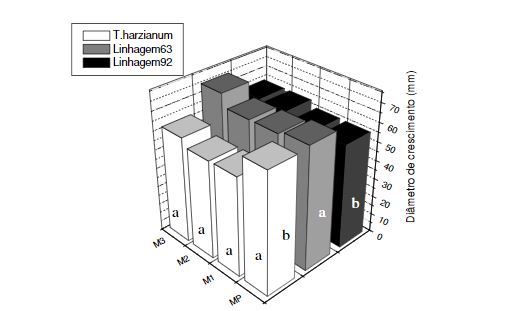Babassu coconut mesocarp (Orbignyasp.) as carbon source for production of culture media for Trichoderma
DOI:
https://doi.org/10.20873/jbb.uft.cemaf.v5n1.francaKeywords:
Phaseolus vulgaris L., abiotic stress, germination, vigorAbstract
Biological control has been studied as an alternative replacement of chemicals in agriculture . One of the microorganisms used in this system is the fungal species Trichoderma sp. In this work, media formulations were tested by replacing glucose babassu mesocarp (Orbignia sp.) Which has 69.46% starch in the composition. These culture media were used to cultivate three strains of the fungus Trichoderma . It was observed that the composition of the medium did not affect the growth of which statistically tested concentrations did not differ . For the time of 72h was no significant difference (p < 0.05) in diameter growth of strain 63 for the other however to the total time of the experiment the standard species proved stronger for longer, staying in log phase to the time 96 hours. The concentrations of immediate substituted carbon source (dextrose) at babassu mesocarp did not affect the growth of the fungus suggests that the mesocarp babassu is a good carbon source for the production of growth medium.

Published
How to Cite
Issue
Section
License
Copyright (c) 2024 - Journal of Biotechnology and Biodiversity

This work is licensed under a Creative Commons Attribution 4.0 International License.
Authors who publish with this journal agree to the following terms:
Authors retain copyright and grant the journal right of first publication with the work simultaneously licensed under a Creative Commons Attribution License (CC BY 4.0 at http://creativecommons.org/licenses/by/4.0/) that allows others to share the work with an acknowledgement of the work's authorship and initial publication in this journal.
Authors are able to enter into separate, additional contractual arrangements for the non-exclusive distribution of the journal's published version of the work (e.g., post it to an institutional repository or publish it in a book), with an acknowledgement of its initial publication in this journal.
Authors are permitted and encouraged to post their work online (e.g. in institutional repositories or on their website) prior to and during the submission process, as it can lead to productive exchanges, as well as earlier and greater citation of published work (Available at The Effect of Open Access, at http://opcit.eprints.org/oacitation-biblio.html).


